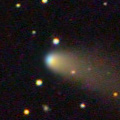
|
Now it is so bright as 9.6 mag (Dec. 29, Maik Meyer). It keeps as bright as 9-10 mag for a long time until spring. It will be observable in good condition for a long time after this in the Northern Hemisphere. It keeps visible visually for one year until 2010 autumn.
Date(TT) R.A. (2000) Decl. Delta r Elong. m1 Best Time(A, h)
Dec. 26 13 36.13 23 53.2 2.340 2.428 83 9.3 5:35 (290, 65)
Jan. 2 13 49.31 26 23.1 2.293 2.458 87 9.3 5:37 (289, 70)
|
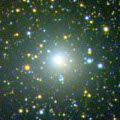
|
It reached up to 7.7 mag in summer (Aug. 13, Chris Wyatt). It is fading now. It has already faded down to 10.2 mag (Dec. 11, Carlos Labordena). Now it is not observable. In the Southern Hemisphere, it will appear in the morning sky in late February, then it keeps observable for a long time. But in the Northern Hemisphere, it is only observable in the low sky in spring, then it will never be observable again.
Date(TT) R.A. (2000) Decl. Delta r Elong. m1 Best Time(A, h)
Dec. 26 19 34.38 -17 27.9 4.456 3.539 18 10.3 18:25 ( 69, 0)
Jan. 2 19 38.67 -18 11.5 4.524 3.570 12 10.4 18:30 ( 72, -6)
|
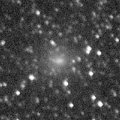
|
It reached up to 8.4 mag in October (Oct. 20, Marco Goiato). Now it is fading. But it is bright as 9.7 mag still now (Dec. 20, Marco Goiato). In the Northern Hemisphere, it keeps observable in the low sky until February when it fades down to 13.5 mag.
Date(TT) R.A. (2000) Decl. Delta r Elong. m1 Best Time(A, h)
Dec. 26 21 29.03 -18 8.1 2.122 1.582 44 10.5 18:25 ( 49, 20)
Jan. 2 21 50.31 -16 16.2 2.194 1.620 42 10.8 18:30 ( 53, 19)
|
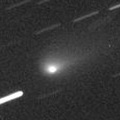
|
Now it is so bright as 10.3 mag (Dec. 29, Maik Meyer). It keeps observable bright as 9-10 mag in a good condition for a long time from winter to spring. It keeps observable until 2010 autumn when it fades down to 16 mag.
Date(TT) R.A. (2000) Decl. Delta r Elong. m1 Best Time(A, h)
Dec. 26 11 57.20 0 55.5 1.300 1.700 95 10.8 5:35 (358, 56)
Jan. 2 12 12.56 -0 23.7 1.225 1.678 98 10.6 5:27 ( 0, 55)
|
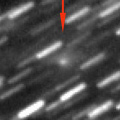
|
Although CCD observers reported it as faint as 14-15 mag, it looks bright visually as 11.6 mag (Dec. 7, Chris Wyatt). Juan Jose Gonzalez reported it was significantly bright as 9.2 mag on Nov. 18. In the Southern Hemisphere, it keeps observable all through this apparition, although it becomes low in November and December. Especially, it will be observable in the excellent condition after January. In the Northern Hemisphere, it is not observable now. But it will appear in the morning sky at 14 mag in late January, then it keeps observable while fading gradually.
Date(TT) R.A. (2000) Decl. Delta r Elong. m1 Best Time(A, h)
Dec. 26 18 26.68 -57 21.3 0.269 0.775 34 10.7 18:25 ( 38,-32)
Jan. 2 16 43.37 -68 38.4 0.222 0.856 49 11.2 5:37 (338,-24)
|
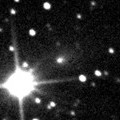
|
Now it is 12.7 mag (Dec. 16, Marco Goiato). It is a bit fainter than expected. In the Northern Hemisphere, it keeps observable in good condition for a long time after this until 2010 spring when it fades out.
Date(TT) R.A. (2000) Decl. Delta r Elong. m1 Best Time(A, h)
Dec. 26 5 52.47 8 51.3 1.020 1.985 164 11.9 23:31 ( 0, 64)
Jan. 2 5 48.15 9 26.2 1.031 1.984 160 11.9 22:59 ( 0, 64)
|
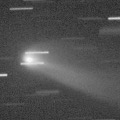
|
An outburst occured on Oct. 13, and it reached up to 8.5 mag on Oct. 15 (Toru Yusa). The central nucleus shined like a bright star, and the dust coma looked like 17P/Holmes in outburst. However, the comet returned to the normal state within a few days. Now it is 12.1 mag (Dec. 18, Marco Goiato). It will fade out rapidly, and will be fainter than 14 mag in late January. In the Northern Hemisphere, it keeps observable in good condition for a long time until spring when it becomes fainter than 18 mag.
Date(TT) R.A. (2000) Decl. Delta r Elong. m1 Best Time(A, h)
Dec. 26 5 43.00 7 1.7 0.835 1.796 161 12.2 23:22 ( 0, 62)
Jan. 2 5 37.52 8 55.8 0.904 1.852 157 12.6 22:49 ( 0, 64)
|

|
Outbursts occured repeatedly since September, and it keeps visible visually. It is bright as 12.0 mag still now (Dec. 12, Juan Jose Gonzalez).
Date(TT) R.A. (2000) Decl. Delta r Elong. m1 Best Time(A, h)
Dec. 26 9 52.52 11 37.7 5.530 6.183 127 13.6 3:35 ( 0, 67)
Jan. 2 9 50.98 11 39.4 5.446 6.185 135 13.6 3:06 ( 0, 67)
|
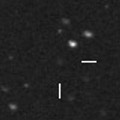
|
It is expected to reach up to 10 mag and to be observable in good condition in spring. Now it is not observable. It will appear in the morning sky at 13 mag in late January.
Date(TT) R.A. (2000) Decl. Delta r Elong. m1 Best Time(A, h)
Dec. 26 17 33.60 -28 37.8 3.187 2.231 11 14.0 5:35 (296,-12)
Jan. 2 17 42.36 -27 3.9 3.093 2.163 15 13.8 5:37 (298, -8)
|
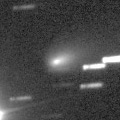
|
It has brightened much faster than expected. Now it is so bright as 11.8 mag (Dec. 12, Juan Jose Gonzalez). It will be fading after January. It keeps observable in good condition for a long time. But it may fade out very rapidly.
Date(TT) R.A. (2000) Decl. Delta r Elong. m1 Best Time(A, h)
Dec. 26 10 19.06 5 8.8 0.602 1.382 119 14.0 4:01 ( 0, 60)
Jan. 2 10 28.51 6 29.7 0.591 1.407 124 14.3 3:43 ( 0, 61)
|

|
Now it is not observable. It will appear in the morning sky again in 2010 February. It will brighten up to 12-13 mag in 2010 summer. But it locates somewhat low in the Northern Hemisphere.
Date(TT) R.A. (2000) Decl. Delta r Elong. m1 Best Time(A, h)
Dec. 26 16 49.10 -22 3.7 3.371 2.475 20 14.2 5:35 (297, 0)
Jan. 2 17 3.61 -22 41.9 3.330 2.468 24 14.1 5:37 (300, 2)
|
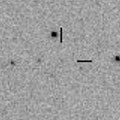
|
Now it is 15.6 mag (Dec. 6, A. Maury, J. B. de Vanssay, F. Mallia, F. Kugel). It will be 14 mag from winter to spring in 2010. But the condition is bad. Now it is not observable in the Northern Hemisphere. But in the Southern Hemisphere, it keeps observable until mid January. In the Northern Hemisphere, it will appear in the morning sky at 15 mag in late May in 2010, then it keeps observable while fading gradually after that.
Date(TT) R.A. (2000) Decl. Delta r Elong. m1 Best Time(A, h)
Dec. 26 21 16.35 -34 42.1 2.466 1.828 40 14.4 18:25 ( 41, 5)
Jan. 2 21 32.33 -31 24.7 2.489 1.804 37 14.3 18:30 ( 45, 5)
|

|
It brightened up to 11 mag in spring and summer in 2009. Now it is not observable. It will be observable again in the morning sky after late January. But it locates somewhat low in the Northern Hemisphere.
Date(TT) R.A. (2000) Decl. Delta r Elong. m1 Best Time(A, h)
Dec. 26 16 55.22 -24 32.1 3.351 2.442 19 14.4 5:35 (298, -3)
Jan. 2 17 9.84 -24 57.0 3.340 2.463 22 14.5 5:37 (301, 0)
|
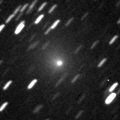
|
It brightened up to 8.5 mag in May and June (May 26, Juan Jose Gonzalez). Now it is fading. It was still bright as 11.6 mag in October (Oct. 10, Marco Goiato). However, it is already too faint to see visually. It will never be observable again in the Northern Hemisphere. In the Southern Hemisphere, it will be low temporarily in winter, but it keeps observable until when it fades out.
Date(TT) R.A. (2000) Decl. Delta r Elong. m1 Best Time(A, h)
Dec. 26 18 54.63 -49 17.0 3.813 2.969 26 15.1 18:25 ( 46,-24)
Jan. 2 19 9.12 -48 26.4 3.901 3.045 25 15.2 18:30 ( 48,-26)
|
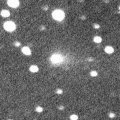
|
Now it is 13.4 mag, already visible visually (Dec. 24, Marco Goiato). It will be observable at 15 mag in good condition in winter and spring.
Date(TT) R.A. (2000) Decl. Delta r Elong. m1 Best Time(A, h)
Dec. 26 5 1.15 14 6.1 1.181 2.130 159 15.1 22:40 ( 0, 69)
Jan. 2 4 56.10 14 38.8 1.184 2.103 152 15.1 22:08 ( 0, 70)
|
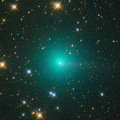
|
It brightened up to 6.7 mag in June (June 9, Marco Goiato). Now it is 14.2 mag (Dec. 14, Ken-ichi Kadota), a bit brighter than this ephemeris. It must be visible visually still now. It will be fading after this, and keeps observable until next spring when it becomes fainter than 18 mag.
Date(TT) R.A. (2000) Decl. Delta r Elong. m1 Best Time(A, h)
Dec. 26 13 42.10 24 30.2 2.854 2.891 82 15.1 5:35 (287, 64)
Jan. 2 13 40.88 27 13.1 2.789 2.953 89 15.3 5:37 (290, 72)
|
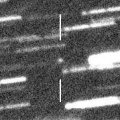
|
It is expected to be bright as 9-10 mag in the northern sky in March and April. It must have been observable in the morning sky until mid December. However, few observations have been reported since October. Now it is not observable. It will appear in the morning sky at 13.5 mag in late January, then it will brighten rapidly. In the Southern Hemisphere, it will be observable in the low sky after the perihelion passage only.
Date(TT) R.A. (2000) Decl. Delta r Elong. m1 Best Time(A, h)
Dec. 26 19 13.86 -2 35.6 2.590 1.746 24 15.5 18:25 ( 84, 5)
Jan. 2 19 19.61 -1 20.5 2.507 1.646 22 15.2 18:30 ( 89, 0)
|

|
It will pass the perihelion in late December. It will brighten very rapidly near by the perihelion. However, the condition is very bad in this apparition. Extremely hard to recover.
Date(TT) R.A. (2000) Decl. Delta r Elong. m1 Best Time(A, h)
Dec. 26 19 36.62 -23 17.9 1.702 0.824 17 15.2 18:25 ( 63, -3)
Jan. 2 20 16.65 -21 56.1 1.676 0.826 20 15.2 18:30 ( 63, -1)
|
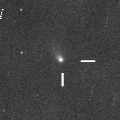
|
New periodic comet, brightened very rapidly. Now it is 14.8 mag and visible visually (Dec. 4, Juan Jose Gonzalez). It is observable at 15 mag in good condition in winter.
Date(TT) R.A. (2000) Decl. Delta r Elong. m1 Best Time(A, h)
Dec. 26 2 6.91 -6 30.3 1.147 1.767 111 15.2 19:47 ( 0, 48)
Jan. 2 2 16.45 -7 19.2 1.202 1.759 106 15.3 19:29 ( 0, 48)
|

|
It brightned up to 10 mag from late 2008 to early 2009. Now it is fading. But it is still bright as 16.0 mag (Dec. 1, Ken-ichi Kadota). It will be observable in good condition again in winter at 15-16 mag. Then it may be still visible visually.
Date(TT) R.A. (2000) Decl. Delta r Elong. m1 Best Time(A, h)
Dec. 26 10 25.51 3 55.8 4.735 5.261 117 15.3 4:08 ( 0, 59)
Jan. 2 10 23.60 3 40.3 4.692 5.315 124 15.3 3:38 ( 0, 59)
|
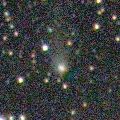
|
It brightened up to 11.5 mag in 2008 summer (Aug. 4, Marco Goiato). Now it is 15.8 mag (Dec. 18, A. Novichonok, A. Smirnov, S. Plaksa). It keeps observable in good condition for a long time in the Southern Hemisphere. Now it became observable again also in the Northern Hemisphere. It will keep 15-16 mag until next spring.
Date(TT) R.A. (2000) Decl. Delta r Elong. m1 Best Time(A, h)
Dec. 26 5 8.33 -39 14.6 4.291 4.794 115 15.5 22:47 ( 0, 16)
Jan. 2 5 0.79 -37 56.6 4.362 4.846 113 15.6 22:12 ( 0, 17)
|
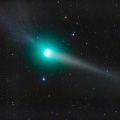
|
It passed near by the earth in late February in 2009, and it reached up to 4.9 mag (Feb. 23, Juan Jose Gonzalez). Now it is 16.2 mag (Dec. 22, R. Garcia). It will be low in the evening sky at 17-18 mag in 2010 spring.
Date(TT) R.A. (2000) Decl. Delta r Elong. m1 Best Time(A, h)
Dec. 26 5 21.34 21 8.9 3.589 4.551 166 15.5 23:00 ( 0, 76)
Jan. 2 5 11.07 20 59.5 3.698 4.620 157 15.7 22:22 ( 0, 76)
|
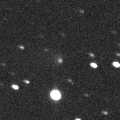
|
Now it is 16.4 mag (Nov. 3, Ken-ichi Kadota). It will reach up to 12 mag in 2012, and will be observable visually at 12-13 mag for a long time from 2011 to 2013. In 2009, it is observable in good condition at 16 mag from summer to autumn. In the Northern Hemisphere, the comet will be low around its brightest seasons.
Date(TT) R.A. (2000) Decl. Delta r Elong. m1 Best Time(A, h)
Dec. 26 21 38.54 -1 24.6 8.530 7.980 53 15.7 18:25 ( 60, 33)
Jan. 2 21 39.42 -1 26.7 8.588 7.944 46 15.7 18:30 ( 66, 28)
|
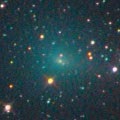
|
It brightened up to 8.8 mag in May and June (May 19, Juan Jose Gonzalez). It has already faded down to 15.7 mag (Dec. 23, Ken-ichi Kadota). It keeps observable in the evening sky for a long time until next spring when it becomes fainter than 18 mag.
Date(TT) R.A. (2000) Decl. Delta r Elong. m1 Best Time(A, h)
Dec. 26 23 45.96 -6 33.7 2.490 2.514 80 15.7 18:25 ( 21, 46)
Jan. 2 23 54.92 -5 27.4 2.620 2.556 75 15.9 18:30 ( 30, 45)
|
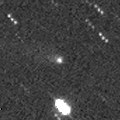
|
Now it is 16.8 mag (Dec. 18, Ken-ichi Kadota), a bit fainter than this ephemeris. It will be observable at 16 mag in good condition until spring.
Date(TT) R.A. (2000) Decl. Delta r Elong. m1 Best Time(A, h)
Dec. 26 15 44.22 20 39.0 3.339 2.936 57 15.8 5:35 (270, 38)
Jan. 2 15 44.11 20 42.5 3.277 2.959 62 15.8 5:37 (274, 44)
|
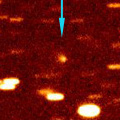
|
Now it is 16.6 mag (Dec. 8, C. Rinner, F. Kugel). The condition of this apparition is bad. It will reach up to 11-12 mag from spring to autumn in 2010, but it is not observable. It will be getting brighter gradually in the evening sky, but it will be too low to observe in January at 15 mag.
Date(TT) R.A. (2000) Decl. Delta r Elong. m1 Best Time(A, h)
Dec. 26 21 30.17 -0 52.6 2.819 2.340 51 16.0 18:25 ( 62, 32)
Jan. 2 21 41.31 -0 19.7 2.838 2.291 47 15.9 18:30 ( 67, 29)
|
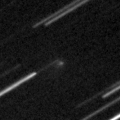
|
Now it is 15.7 mag (Dec. 27, Yasukazu Ikari). It will be observable at 15.5 mag in the evening sky until spring.
Date(TT) R.A. (2000) Decl. Delta r Elong. m1 Best Time(A, h)
Dec. 26 1 23.84 35 10.9 1.185 1.844 116 16.0 19:03 (180, 90)
Jan. 2 1 12.01 36 60.0 1.217 1.785 107 15.9 18:30 (152, 88)
|

|
Now it is 16.6 mag (Dec. 5, Ken-ichi Kadota). It was observed as 15-16 mag in early 2009. In 2010, it will be observable at 16 mag in good condition from winter to spring.
Date(TT) R.A. (2000) Decl. Delta r Elong. m1 Best Time(A, h)
Dec. 26 13 33.19 -3 22.5 3.784 3.595 71 16.0 5:35 (323, 45)
Jan. 2 13 38.92 -3 48.7 3.688 3.599 77 16.0 5:37 (331, 47)
|
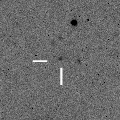
|
Now it is 16.8 mag (Dec. 20, J. M. Trigo-Rodriguez). It is expected to brighten rapidly and to be observable at 15 mag in good condition from winter to spring. However, it is a bit fainter than this ephemeris recently.
Date(TT) R.A. (2000) Decl. Delta r Elong. m1 Best Time(A, h)
Dec. 26 10 33.95 17 11.0 1.676 2.331 120 16.1 4:16 ( 0, 72)
Jan. 2 10 37.62 17 22.3 1.595 2.318 126 16.0 3:52 ( 0, 72)
|

|
It brightened up to 13 mag and observed visually from 2007 to 2009. Due to the far distance, it is bright as 15.7 mag still now (Dec. 28, P. C. Sherrod). It will be observable in good condition again until spring.
Date(TT) R.A. (2000) Decl. Delta r Elong. m1 Best Time(A, h)
Dec. 26 13 28.10 32 50.5 7.462 7.511 89 16.1 5:35 (270, 70)
Jan. 2 13 27.26 33 32.0 7.391 7.542 95 16.1 5:37 (272, 77)
|
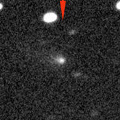
|
It brightened up to 11 mag in outburst in 2003. However, it does not seem to be so bright in this apparition. Now it is 16.2 mag (Dec. 26, Ken-ichi Kadota). It will be observable in good condition in winter. But it seems to brighten only up to 16 mag.
Date(TT) R.A. (2000) Decl. Delta r Elong. m1 Best Time(A, h)
Dec. 26 0 7.52 11 10.3 1.102 1.502 91 16.3 18:25 ( 22, 65)
Jan. 2 0 21.77 12 2.1 1.120 1.471 88 16.2 18:30 ( 32, 64)
|
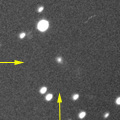
|
Appearing in the morning sky. It will be observable at 15 mag for a long time in 2010.
Date(TT) R.A. (2000) Decl. Delta r Elong. m1 Best Time(A, h)
Dec. 26 16 46.12 9 25.7 5.747 5.031 39 16.3 5:35 (272, 19)
Jan. 2 16 52.93 10 1.8 5.673 5.007 43 16.3 5:37 (275, 24)
|
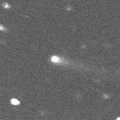
|
Now it is 15.9 mag (Dec. 18, Ken-ichi Kadota). This comet tends to brighten after the perihelion passage. It will be observable at 16 mag in 2010 and 2011. It is brighter than this ephemeris recently.
Date(TT) R.A. (2000) Decl. Delta r Elong. m1 Best Time(A, h)
Dec. 26 4 26.49 24 4.7 2.276 3.191 154 16.8 22:06 ( 0, 79)
Jan. 2 4 23.29 23 49.6 2.321 3.188 146 16.8 21:35 ( 0, 79)
|
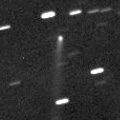
|
Now it is 16.9 mag (Dec. 22, Toru Yusa). It has a very long tail in spite of the distance. It passed the perihelion in 2009, but it was brighter in 2008. It will be fading after this, and will be fainter than 18 mag in next spring.
Date(TT) R.A. (2000) Decl. Delta r Elong. m1 Best Time(A, h)
Dec. 26 22 58.14 32 4.6 4.061 4.125 86 16.9 18:25 ( 90, 68)
Jan. 2 23 0.87 32 28.1 4.171 4.145 81 17.0 18:30 ( 95, 62)
|

|
It passed the perihelion in September, and brightened up to 14.6 mag (Sept. 19, Hidetaka Sato). It is fading now, but still bright as 16.5 mag (Dec. 20, J. M. Aymami). It keeps observable in good condition until February when it becomes fainter than 18 mag.
Date(TT) R.A. (2000) Decl. Delta r Elong. m1 Best Time(A, h)
Dec. 26 22 49.87 11 31.0 1.796 1.810 74 16.9 18:25 ( 55, 55)
Jan. 2 23 4.01 13 44.8 1.916 1.869 72 17.1 18:30 ( 63, 54)
|
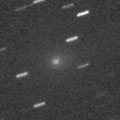
|
Fading slowly. Now it is 16.9 mag (Dec. 23, Ken-ichi Kadota). It keeps observable in good condition until February when it becomes fainter than 18 mag.
Date(TT) R.A. (2000) Decl. Delta r Elong. m1 Best Time(A, h)
Dec. 26 10 15.80 7 53.7 1.875 2.528 121 16.9 3:58 ( 0, 63)
Jan. 2 10 12.87 7 42.2 1.849 2.582 128 17.0 3:28 ( 0, 63)
|
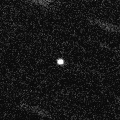
|
The condition is good in this apparition. It approached to the earth down to 0.38 A.U., and brightened up to 15.9 mag (Nov. 24, A. Sanchez). Now it is fading. It has already faded down to 16.7 mag (Dec. 14, Katsumi Yoshimoto). It will be fainter than 18 mag in mid January.
Date(TT) R.A. (2000) Decl. Delta r Elong. m1 Best Time(A, h)
Dec. 26 1 29.21 11 45.0 0.577 1.304 110 17.1 19:11 ( 0, 67)
Jan. 2 1 58.08 13 45.0 0.652 1.360 110 17.4 19:12 ( 0, 69)
|
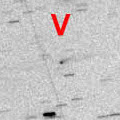
|
Now it is 17.9 mag (Dec. 5, Ken-ichi Kadota). It will be fainter than 18 mag in March.
Date(TT) R.A. (2000) Decl. Delta r Elong. m1 Best Time(A, h)
Dec. 26 11 9.95 14 21.2 1.462 2.034 111 17.1 4:52 ( 0, 69)
Jan. 2 11 13.28 15 19.2 1.430 2.077 117 17.2 4:28 ( 0, 70)
|
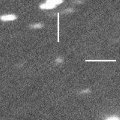
|
Now it is 18.0 mag (Dec. 19, Ken-ichi Kadota). It keeps observable at 17 mag for a long time from 2010 to 2012.
Date(TT) R.A. (2000) Decl. Delta r Elong. m1 Best Time(A, h)
Dec. 26 2 30.61 17 53.1 8.002 8.626 126 17.4 20:10 ( 0, 73)
Jan. 2 2 27.07 17 41.2 8.094 8.611 118 17.4 19:39 ( 0, 73)
|

|
Now it is 18.4 mag (Dec. 18, Yasukazu Ikari). It will be observable at 17.5 mag in good condition in early 2010 and early 2011.
Date(TT) R.A. (2000) Decl. Delta r Elong. m1 Best Time(A, h)
Dec. 26 5 33.55 20 24.6 2.628 3.599 169 17.7 23:12 ( 0, 75)
Jan. 2 5 28.74 20 29.1 2.646 3.591 161 17.7 22:40 ( 0, 75)
|
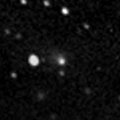
|
It brightened up to 15-16 mag in 2008 summer. Now it is 17.6 mag (Dec. 22, Yasukazu Ikari). It will be fainter than 18 mag in January.
Date(TT) R.A. (2000) Decl. Delta r Elong. m1 Best Time(A, h)
Dec. 26 3 1.93 33 41.3 2.551 3.330 136 17.7 20:42 ( 0, 89)
Jan. 2 3 0.88 33 16.9 2.640 3.349 129 17.9 20:13 ( 0, 88)
|

|
Now it is 17.7 mag (Dec. 21, Ken-ichi Kadota). It will be observable at 17.5 mag in good condition in winter.
Date(TT) R.A. (2000) Decl. Delta r Elong. m1 Best Time(A, h)
Dec. 26 10 5.55 31 26.1 2.301 3.023 129 17.8 3:48 ( 0, 86)
Jan. 2 10 5.41 32 10.7 2.245 3.030 135 17.8 3:20 ( 0, 87)
|

|
New periodic comet which brightened up to 14 mag in 2004 and 2005. It should be observable at 18 mag also around the aphelion. However, no observations have been reported since 2008 January. It seems to have faded out rapidly. Now it is fainter than 20.4 mag actually (Sept. 16, Leonid Elenin).
Date(TT) R.A. (2000) Decl. Delta r Elong. m1 Best Time(A, h)
Dec. 26 6 49.13 30 8.0 4.014 4.986 170 20.0 0:32 ( 0, 85)
Jan. 2 6 44.10 30 24.3 4.002 4.979 172 20.0 0:00 ( 0, 85)
|
|
![]()
 P/2009 T2 ( La Sagra )
P/2009 T2 ( La Sagra ) C/2006 OF2 ( Broughton )
C/2006 OF2 ( Broughton ) C/2007 G1 ( LINEAR )
C/2007 G1 ( LINEAR ) C/2007 N3 ( Lulin )
C/2007 N3 ( Lulin ) C/2006 S3 ( LONEOS )
C/2006 S3 ( LONEOS ) 22P/Kopff
22P/Kopff C/2008 N1 ( Holmes )
C/2008 N1 ( Holmes ) 43P/Wolf-Harrington
43P/Wolf-Harrington C/2009 U3 ( Hill )
C/2009 U3 ( Hill ) 74P/Smirnova-Chernykh
74P/Smirnova-Chernykh 94P/Russell 4
94P/Russell 4 C/2005 L3 ( McNaught )
C/2005 L3 ( McNaught ) 157P/Tritton
157P/Tritton C/2008 FK75 ( Lemmon-Siding Spring )
C/2008 FK75 ( Lemmon-Siding Spring ) 203P/2008 R4 ( Korlevic )
203P/2008 R4 ( Korlevic ) C/2008 P1 ( Garradd )
C/2008 P1 ( Garradd ) (3552) Don Quixote
(3552) Don Quixote 64P/Swift-Gehrels
64P/Swift-Gehrels 107P/(4015) Wilson-Harrington
107P/(4015) Wilson-Harrington 230P/2009 U6 ( LINEAR )
230P/2009 U6 ( LINEAR ) C/2008 S3 ( Boattini )
C/2008 S3 ( Boattini ) 31P/Schwassmann-Wachmann 2
31P/Schwassmann-Wachmann 2 47P/Ashbrook-Jackson
47P/Ashbrook-Jackson 232P/2009 W1 ( Hill )
232P/2009 W1 ( Hill ) P/2004 F3 ( NEAT )
P/2004 F3 ( NEAT )![]()





































